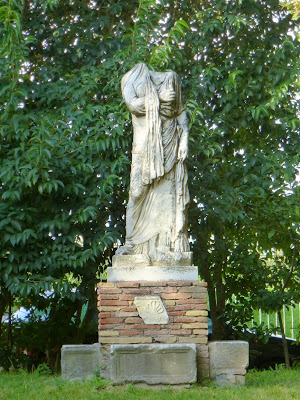Ten miles down the Tiber, Ostia was Rome's port for a millennium, give or take. At its height, 50,000 people lived and worked there, in the shipping businesses, import/export, warehousing, service industries, etc. Probably also cruises and tours. Ostia was abandoned in the 5th century because of raids, malaria, high cost of flood and pirate insurance, etc. Also Rome fell, so to speak. For the next several centuries Ostia silted up, up past the second story of many buildings. And so, a bit like Pompeii, much was preserved in Ostia. Treasure-hunting and then serious archaeology began in the 19th century, and today we have a very sizable and interesting Roman city--an important one--to examine. We took the Metro to EUR Magliana and then transferred to the Lido line and spent most of the day looking at Ostia.
 |
| In the necroplis. Minerva as Victory |
 |
Seriously, in the Baths of Neptune, a mosaic the size of a
basketball court; looking down--note shadows--from a three
story high observation platform; for Romans, baths were
not merely for bathing...they were multi-use community health
and recreation centers, with athletic facilities, etc. |
 |
Up closer, there's Neptune riding his chariot; the Baths of
Neptune were not even Ostia's largest...but certainly most
scenic now |
 |
| Amphitheater |
 |
| So it said |
 |
Of all the sights in Ostia, perhaps the most interesting and
impressive is the Piazzale delle Corporazioni, a large piazza
(with a small podium temple in the center) around which
were ranged some scores of business offices--the assorted
ship-builders, shipping lines, import/export dealers,
stevedores, warehouses, lighter shipping up the Tiber,
etc.--as the port of Rome, Ostia would have been the greatest
port of the world, and each office or corporation would have
had its own mosaic emblem |
 |
Palm oil--the amphora bears the letters MC, "Caesar's
Mauretania" |
 |
Suppliers and purveyors of exotic and wild game...for the
Coliseum, presumably |
 |
Typical scenery at Ostia, much more pleasantly vegetated
than Pompeii |
 |
| One of the public latrines |
 |
| Capitolium and Temple of Augustus |



























































